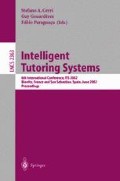Abstract
Recent studies reveal that human tutoring sessions do not always end when the student has solved a problem. Instead, tutors and students frequently use a post-practice discussion to bring new topics to the table or to continue problem-solving discussions. One of the main roles of post-practice dialogues is to support transfer—that is, the student’s ability to apply concepts and adapt familiar solution strategies to unfamiliar problems. Several developers of intelligent tutoring systems have implemented post-practice modules, with similar aims. However, in contrast to the integrated instructional planning that human tutors apparently perform, automated planning of reflective activities is typically done independently of instructional planning during problem solving. We present a framework for describing reflective plans that are distributed between problem solving and debrief and evidence that reflective discussions support transfer in elementary mechanics.
Access this chapter
Tax calculation will be finalised at checkout
Purchases are for personal use only
Preview
Unable to display preview. Download preview PDF.
References
Katz, S., O’Donnell, G., & Kay, H. (2000). An approach to analyzing the role and structure of reflective dialogue. International Journal of Artificial Intelligence and Education, 11, 320–343.
Kieras, D.E., & Bovair, S. (1984). The role of a mental model in learning to operate a device. Cognitive Science, 8, 255–273.
Marshall, S. P. (1995). Schemas in Problem Solving. New York, NY: Cambridge University Press.
Katz, S., Lesgold, A., Hughes, E., Peters, D., Eggan, G., Gordin, M., Greenberg., L. (1998). Sherlock 2: An intelligent tutoring system built upon the LRDC Tutor Framework. InC. P. Bloom and R. B. Loftin (Eds.), Facilitating the Development and Use of Interactive Learning Environments (pp. 227–258). New Jersey: Lawrence Erlbaum Associates.
Smith-Jentsch, K. A., Zeisig, R. L., Acton, B., & McPherson, J. A. (1998). Team dimensional training: A strategy for guided team self-correction. In J. A. Cannon-Bowers & E. Salas (Eds.), Making decisions under stress: Implications for individual and team training (pp. 271–297). Washington, DC: APA.
Lee, A. Y., & Hutchison, L. (1998). Improving learning from examples through reflection. Journal of Experimental Psychology: Applied, 4(3), 187–210.
Gertner, A. & VanLehn, K. (2000). Andes: A Coached Problem Solving Environment for Physics. In G. Gauthier, C. Frasson, and K. VanLehn (Eds.), Proceedings of the 5th International Conference, ITS 2000 [133–142], Montreal, Canada.
Katz, S., & Allbritton, D. (submitted). Adaptive tutoring that takes place after a problem has been solved.
Mann, W., & Thompson, S. (1988). Rhetorical structure theory: Towards a functional theory of text organization. TEXT, 8(3), 243–281.
Hume, G. D., Michael, J., Rovick, A., & Evens, M. (1996). Hinting as a tactic in one-on-one tutoring. Journal of the Learning Sciences, 5(1), pp. 23–47.
Author information
Authors and Affiliations
Editor information
Editors and Affiliations
Rights and permissions
Copyright information
© 2002 Springer-Verlag Berlin Heidelberg
About this paper
Cite this paper
Katz1, S., Allbritton, D. (2002). Going Beyond the Problem Given: How Human Tutors Use Post-practice Discussions to Support Transfer. In: Cerri, S.A., Gouardères, G., Paraguaçu, F. (eds) Intelligent Tutoring Systems. ITS 2002. Lecture Notes in Computer Science, vol 2363. Springer, Berlin, Heidelberg. https://doi.org/10.1007/3-540-47987-2_65
Download citation
DOI: https://doi.org/10.1007/3-540-47987-2_65
Published:
Publisher Name: Springer, Berlin, Heidelberg
Print ISBN: 978-3-540-43750-5
Online ISBN: 978-3-540-47987-1
eBook Packages: Springer Book Archive

